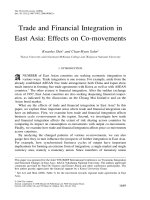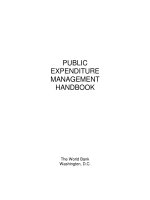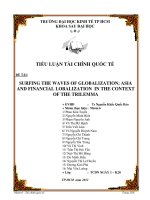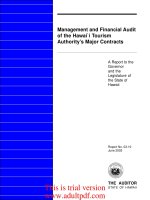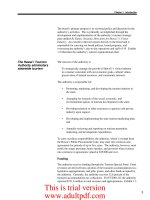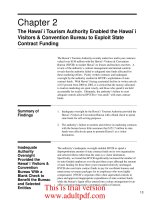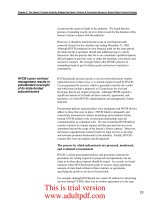Public expenditure management and financial accountability in niger (world bank country study)
Bạn đang xem bản rút gọn của tài liệu. Xem và tải ngay bản đầy đủ của tài liệu tại đây (2.29 MB, 150 trang )
A
W O R L D
B A N K
C O U N T R Y
S T U D Y
Public Expenditure
Management and
Financial Accountability
in Niger
THE WORLD BANK
A
W O R L D
B A N K
C O U N T R Y
S T U D Y
Public Expenditure
Management and Financial
Accountability in Niger
THE WORLD BANK
Washington, D.C.
Copyright © 2005
The International Bank for Reconstruction and Development / The World Bank
1818 H Street, N.W.
Washington, D.C. 20433, U.S.A.
All rights reserved
Manufactured in the United States of America
First Printing: October 2005
printed on recycled paper
1 2 3 4 5 07 06 05
World Bank Country Studies are among the many reports originally prepared for internal
use as part of the continuing analysis by the Bank of the economic and related conditions of
its developing member countries and to facilitate its dialogs with the governments. Some of
the reports are published in this series with the least possible delay for the use of governments,
and the academic, business, financial, and development communities. The manuscript of this
paper therefore has not been prepared in accordance with the procedures appropriate to
formally-edited texts. Some sources cited in this paper may be informal documents that are
not readily available.
The findings, interpretations, and conclusions expressed herein are those of the author(s)
and do not necessarily reflect the views of the International Bank for Reconstruction and
Development/The World Bank and its affiliated organizations, or those of the Executive
Directors of The World Bank or the governments they represent.
The World Bank does not guarantee the accuracy of the data included in this work.
The boundaries, colors, denominations, and other information shown on any map in this
work do not imply and judgment on the part of The World Bank of the legal status of any
territory or the endorsement or acceptance of such boundaries.
The material in this publication is copyrighted. Copying and/or transmitting portions
or all of this work without permission may be a violation of applicable law. The International
Bank for Reconstruction and Development/The World Bank encourages dissemination of its
work and will normally grant permission promptly to reproduce portions of the work.
For permission to photocopy or reprint any part of this work, please send a request with
complete information to the Copyright Clearance Center, Inc., 222 Rosewood Drive, Danvers,
MA 01923, USA, Tel: 978-750-8400, Fax: 978-750-4470, www.copyright.com.
All other queries on rights and licenses, including subsidiary rights, should be addressed
to the Office of the Publisher, The World Bank, 1818 H Street NW, Washington, DC 20433,
USA, Fax: 202-522-2422, email:
ISBN-10: 0-8213-6366-2
eISBN: 0-8213-6367-0
ISSN: 0253-2123
ISBN-13: 978-0-8213-6366-9
DOI: 10.1596/978-0-8213-6366-9
Cover photographs from the website www.agadez-niger.com, courtesy of Samuel Gaze.
Library of Congress Cataloging-in-Publication Data has been requested.
In memory of our dear friend and colleague Jacques Bernard Christien.
Contents
Acknowledgments
ix
Acronyms and Abbreviations
xi
Executive Summary
xv
Introduction
1.
2.
1
Recent Reform Achievements
2
Rationale for PEMFAR
2
Objectives, Scope and Structure
3
Macroeconomic Context
5
Structure of Niger’s Economy and of Public Finance
6
Economic Performance 2000–2003
15
Macroeconomic Outlook and Financing Requirements 2004–2007
18
Solvency and Fiscal Sustainability Analysis
21
Public Expenditure Review
25
Objectives of the Public Expenditure Review
25
Scope of Analysis and Data Constraints
26
Analysis of Public Expenditure Structure
27
Spending Targets for Priority Sectors
27
Analysis of Public Expenditure by Functional Classification
28
Actual Expenditures Compared to PRSP Spending Targets
30
International Comparisons of Functional Distribution of Public Expenditure
31
Factors Determining the Structure of Public Expenditure
32
Economic Composition of Public Expenditures
36
Impact of Budget Execution on Budget Outcomes
40
Geographical Distribution of Public Expenditures and their Poverty Impact
44
Sector Expenditure Reviews
3.
47
Education
47
Health
53
Road Transport
58
Rural Development
63
Assessment of Public Finance Management Systems
67
Budget Preparation
68
Budget Execution
71
v
vi
Contents
The Budget Execution Process
71
Externally Financed Development Expenditures
74
Processing Delegated Budget Credits (credits délégués)
75
Public Accounting and Treasury Management
76
Government Accounts
77
Reporting (Treasury Accounts and Budget Review Law)
78
Treasury System
78
Cash Management
79
Internal and External Controls
80
Ex-Ante Controls
81
Internal Audit
81
External Audit
82
Political Control (National Assembly)
83
Non Financial Assets, Monitoring of Parastatals and Debt Management
84
Non-Financial Assets (Comptabilité Matière)
84
Monitoring of Parastatals
85
Debt Management
86
Institutional and Organizational Reforms and Human Resources Management
87
Institutional and Organizational Reforms
88
Human Resource Management
89
Appendixes
Appendix A: Macroeconomic and Government Finance Tables
91
93
Appendix A.1: Financing of Government Overall Fiscal Deficits
94
Appendix A.2: Sources of Net Official Development Assistance, 1997–2001
95
Appendix A.3: Selected Economic and Financial Indicators, 2004–2007
96
Appendix B: Public Expenditure Data
Appendix B.1: Total Public Expenditures
Appendix B.2: Domestically-financed Public Expenditures
Appendix C: Methodology of Public Expenditure Reclassification Exercise
97
97
101
107
Appendix C.1: Objectives and Main Tasks
107
Appendix C.2: List of Reclassifications and Explanations
108
Appendix C.3: Synthesized Table of Reclassifications
112
References
117
Contents
vii
LIST OF TABLES
1: Priority Action Plan
xxii
1-1: Nominal and Real GDP and Growth Rates, 1997–2003
6
1-2: Niger and WAEMU Convergence Criteria, 1997–2003
9
1-3: Composition of Government Revenue, 1997–2003
9
1-4: Composition of Government Expenditures, 1997–2003 accrual terms
10
1-5: Composition of Government Expenditures, 1997–2003
11
1-6: Overall Fiscal Balance, 1997–2003
12
1-7: Projected HIPC Assistance to Niger after Completion Point
14
1-8: Change in Domestic Arrears (net), 1999–2003
17
1-9: Financial Operations of the Central Government, 2004–2007
Projections of revenues and expenditures
20
1-10: Financial Operations of the Central Government, 2004–2007
Projections of overall balance and financing
21
1-11: Public Sector Solvency and Sustainability in Niger
22
2-1: Quantitative Targets for Priority Sector Spending
28
2-2: Functional Distribution of Public Spending (total expenditures)
29
2-3: Functional Distribution of Public Spending (Recurrent Expenditure)
31
2-4: Medium Term Projections of Priority Sector Expenditures, 2004–2007
33
2-5: Regional Comparison of Spending on Priority Sectors
33
2-6: Importance of Donor Financing for Public Expenditures
33
2-7: Economic Structure of Total Expenditures
37
2-8: Payroll and Wage Bill 2000–2003
38
2-9: Ratio of Recurrent to Capital Expenditures
39
2-10: Ratio of Budget Allocation to Execution by Expenditure Category
41
2-11: Execution Rates by Budget Execution Stage
43
2-12: Primary Education Indicators
48
2-13: Education Sector—Recurrent Expenditures by Subsector
49
2-14: Cost of Contract Teachers
49
2-15: Unit Costs by Subsector
50
2-16: Economic Classification of Education Expenditures
51
2-17: Health Indicators
53
2-18: Economic Classification of Health Expenditures
54
2-19: Health Sector—Recurrent Expenditures by Level
56
2-20: Ratios of Health Workers to Population by Region (2000)
56
2-21: Public Expenditures for Transport and Civil Works
59
2-22: Budget Allocations for Road Maintenance and Actual Expenditures
61
viii
Contents
2-23: Yields of Cereal Production in Niger—Comparison with other
Countries in the Sub-Region
64
2-24: Public Expenditures in the Rural Sector
3-1: Niger’s Budget Execution Process
65
72
LIST OF CHARTS
1-1: Real Output Growth
6
1-2: Evolution of Net ODA to Niger
13
1-3: Government Revenue
17
2-1: Evolution of Public Expenditure by Functional Classification
29
2-2: Evolution of Recurrent Expenditure by Functional Classification
30
2-3: Comparison Total Expenditures—PRSP Spending Targets
32
2-4: Comparison Recurrent Expenditures—PRSP Spending Targets
32
2-5: Sectoral Distribution of Capital Expenditures by Source of Financing
34
2-6: Use of HIPC Resources, 2001–2003
35
2-7: Economic Structure of Total Expenditure
37
2-8: Execution Rates by Sectors
41
2-9: Quarterly Fluctuations in Spending on Goods and Services
42
2-10: Per Capita Levels of Regionally Administered Expenditures by Region
46
2-11: Per Capita Distribution of Spending in the Special Program of the President
46
LIST OF BOXES
1: WAEMU Convergence Criteria
2:
Revenue-Enhancing Measures Introduced since 2001
8
16
3: Rationale for and Impact of Niger’s Cash Management System
44
4: Inter-sectoral Expenditure Structure—Main Recommendations
47
5:
Education—Main Recommendations
52
6:
Health Sector—Main Recommendations
58
7:
Road Transport—Main Recommendations
63
8:
Rural Development Sector—Main Recommendations
66
9:
Budget Preparation—Main Recommendations
70
10:
Exceptional Procedures
73
11:
Budget Execution—Main Recommendations
76
12:
Accounting and Treasury Management—Main Recommendations
80
13: Internal and External Controls—Main Recommendations
84
14: Non-financial Assets, Monitoring of Parastatals and Debt Management—
Main Recommendations
88
15:
Institutional and Organizational Reforms and Human Resources
Management—Main Recommendations
90
Acknowledgments
T
his is the final report of the Niger Public Expenditure Management and Financial
Accountability Review (PEMFAR) undertaken by the World Bank in close partnership
with the Government of Niger and the European Commission (EC). On the Government
side, Adamou Kane (Ministry of Economy and Finance) was responsible for the overall
coordination. The Government team consisted of a core group in the Ministry of Finance
and Economy (MEF) led by Moumouni Saidou and Saadou Bakoye, and four sectoral task
forces. The coordinators of the task forces were: Tari Bako (Road Transport), Adamou
Soumana (Education), Djika Garba (Health), and Adamou Maiguiya (Rural Development).
Members of GAGE (Government group conducting technical work on economic
management) provided key inputs to the macroeconomic analysis.
The analytical work of this report is based on a main mission conducted in November
2003 jointly by the Government, the EC and the Bank. A first draft was discussed in a twoday workshop in June 2004, organized by the Government in Niamey, Niger. The Minister
of Economy and Finance, Mr. Lamine Zeine, presided over the workshop. Participants in the
workshop included representatives from several Government ministries, donor organizations, private sector and civil society organizations. The workshop was led by the following
officials: Djibir Abdoua (MEF), Yacouba Abou (MEF), Rabo Fatchima (MEF), Ibrahim
Garba (MEF), Gani Hamado (MEF), Ibrahim Mamane (Chamber of Accounts), Ibrahim
Samaila (Ministry of Civil Service and Labor),Yaye Seidou (MEF), Abdou Soumana (MEF),
and Kambèye Zabeirou (MEF).
Under the direction of Hinh Dinh (Lead Economist), the World Bank team was led by
Peter Siegenthaler and Amadou Ibrahim (Task Managers, AFTP3). The authors of this
report are Emmanuel Pinto Moreira (AFTP3), Macroeconomic Context, Peter Siegenthaler
(AFTP3), Public Expenditure Review, and Emile Finateu (AFTFM), Public Finance Management Systems. Xavier de la Renaudiere (consultant) played a key role in the drafting process.
The World Bank team also included Amadou Alassane (AFTS3), Jacques Bernard Christien
(AFTFM), Quy-Toan Do (DECRG), Soukeyna Kane (AFTFM), Djibrilla Karamoko
(AFTH2), Anne Mondoloni (AFTFM), Peter Osei (AFTP3), Rachidi Radji (AFTH2), Andreas
Schliessler (AFTTP), Mamadou Yaro (AFTFM), Ali Zafar (AFTP3). Contributions were
made by World Bank consultants Charles N’Cho, Koffi Ekanmian, Jacqueline Freitas,
Stan Manikowski, and Michel Populus.
The European Commission team participating in the PEMFAR was headed by Guy
Samzun (EC, Niamey) and consisted of Xavier le Mounier and Bibata Dille (both EC,
Niamey). EC consultants Lydia Montalti, Claude Boursoit, Jean Petit, and M’hamed Cherif
contributed to the report. Yves Huart from the French Treasury participated as consultant
in the exercise. Other donors, in particular the IMF, UNDP, French Cooperation and AFD,
provided valuable inputs. The PEMFAR process received financial assistance from the Public Expenditure and Financial Accountability Program (PEFA) and the UNDP.
ix
x
Acknowledgments
Peter Moll (AFTP1), Jean Luc Bernasconi (ECSPE), and Moussa Yaya (IMF) were peer
reviewers. The team benefited from the support and guidance of Cadman Mills (Sector
Manager AFTP3), Iraj Talai (AFTM), Vincent Turbat (Country Manager Niger), Pedro Alba
(Country Director, AFC13), and Antoinette Sayeh (former Country Director, AFC13).
Abiodun Olusegun Aina, Maude Jean-Baptiste and Josiane Luchmun (AFTP3) assisted in
the preparation of the report.
Acronyms and Abbreviations
AfDB
BCEAO
CAADIE
CAFER
CAS
CFAA
CET
COGES
CWIQ
DAF
DCE
DCF
DEPP
DFI
DGB
DGIF
DGTP
DO
DPP
DSA
EC
EDS
EFA-FTI
EPA
EPIC
EU
FCFA
FMIS
GAGE
GDP
HDI
African Development Bank
Banque Centrale des Etats de l’Afrique de l’Ouest (Central Bank of West
African States)
Centre Autonome d’Amortissement de la Dette Intérieure de l’Etat
(Central Executing Agency of Domestic Arrears Settlement)
Caisse Autonome pour le Financement de l’Entretien Routier (Autonomous
Road Maintenance Fund)
Country Assistance Strategy
Country Financial Accountability Assessment
Common External Tariff
Comité de Gestion des Etablissements Scolaires (School Management
Committee)
Core Welfare Indicator Questionnaire
Direction des Affaires Administratives et Financières (Financial and
Administrative Affairs Directorate)
Direction du Contentieux de l’Etat (Public Dispute Settlement Directorate)
Direction du Contrôle Financier (Financial Control Directorate)
Direction des Entreprises Publiques et Parapubliques (Directorate of
Public and Parastatal Enterprises)
Direction du Financement de l’Investissement (Investment Finance
Directorate)
Direction Générale du Budget (General Budget Directorate)
Direction Générale de l’ Inspection des Finances (General Directorate for
Financial Inspection)
Direction Générale des Travaux Publics (General Public Works Directorate)
Direction de l’Ordonnancement (Payment Order Directorate)
Direction des Programmes et du Plan (Planning and Programming Directorate)
Debt Sustainability Analysis
European Commission
Enquête Démographique et de Santé (Demographic and Health Survey)
Education for All, Fast Track Initiative
Etablissements Publics à Caractère Administratif (Administrative
Public Enterprises)
Etablissements Publics à Caractère Industriel et Commercial (Industrial and
Commercial Public Enterprises)
European Union
Franc de la Communauté Française de l’Afrique (Franc of the French
Community of Africa)
Financial Management Information System
Groupe d’Appui à la Gestion Economique (Economic Management
Consulting Group)
Gross Domestic Product
Human Development Index
xi
xii
Acronyms and Abbreviations
HIPC
IDA
IGAT
Heavily Indebted Poor Countries
International Development Association
Inspection Générale de l’Administration Territoriale (General Inspectorate for
Territorial Administration)
IGE
Inspection Générale d’Etat (General Public Inspectorate)
IMF
International Monetary Fund
INRAN
Institut National de Recherches Agronomiques du Niger (National Agronomic
Research Institute of Niger)
I-PRSP
Interim Poverty Reduction Strategy
IsDB
Islamic Development Bank
MEAT
Ministère de l’Equipement et de l’Aménagement du Territoire (Equipment
and Territorial Management Ministry)
MEBA
Ministère de l’Education de Base et de l’Alphabétisation (Basic Education and
Alphabetization Ministry)
MEF
Ministry of Economy and Finance
MFP/T
Ministère de la Fonction Publique et du Travail (Public Service and
Labor Ministry)
MSP
Ministère de la Santé Publique (Public Health Ministry)
MTEF
Medium-Term Expenditure Framework
NGO
Non-Governmental Organization
NIGELEC Société Nigérienne d’Électricité (Nigerien Electricity Company)
NPV
Net Present Value
ODA
Overseas Development Aid
OECD
Organization for Economic Cooperation and Development
OPEC
Organization of Petroleum Exporting Countries
OPVN
Office des Produits Vivriers du Niger (National Cereals’ Marketing Board)
PDDE
Programme Décennal pour le Développement de l’Education
(Ten-Year Education Development Program)
PEAC
Public Expenditure Adjustment Credit
PEMFAR Public Expenditure Management and Financial Accountability Review
PER
Public Expenditure Review
PETS
Public Expenditure Tracking Survey
PREM
Poverty Reduction and Economic Management Network (World Bank)
PRGF
Poverty Reduction and Growth Facility
PRS
Poverty Reduction Strategy
PRSC
Poverty Reduction Strategy Credit
PRSP
Poverty Reduction Strategy Paper
PSOP
Paiement sans Ordonnancement Préalable (Payment without preceding
Payment Order)
RDS
Rural Development Strategy
SONIDEP Société Nigérienne des Produits Pétroliers (Nigerien Petrol Product Company)
SNIS
Système National de l’Information Sanitaire
(National Health Information System)
TOFE
Table of Government Financial Operations
UNDP
United Nations Development Program
Acronyms and Abbreviations
UNICEF
VAT
WAEMU
WFP
WHO
United Nations Children Fund
Value Added Tax
West African Economic and Monetary Union
World Food Program
World Health Organization
FISCAL YEAR OF BUDGET
January 1–December 31
CURRENCY EQUIVALENTS
Currency unit: Franc CFA (FCFA)
US$1 = 544 (Exchange rate effective August 2, 2004)
WEIGHT AND MEASURES
Metric system
xiii
Executive Summary
Introduction and Macroeconomic Context
The civilian Government elected in 2000 has made a significant effort to improve Niger’s
fiscal and economic management. Sound macroeconomic and public finance policies
have produced good results. Real GDP growth rates averaged 5.1 percent per annum over
2001–2003 and the basic budget deficit1 was reduced from 3 percent of GDP in 2000 to
1.8 percent in 2003. The falling deficit reflected an increase in Government revenue from
8.0 to 9.7 percent of GDP, and a reduction in recurrent expenditures from 11.2 to 10 percent of GDP, largely due to more effective control of the Government’s wage bill. In addition, the Government successfully reached the Completion Point of the Enhanced Highly
Indebted Poor Countries (HIPC) Initiative in early 2004 giving Niger access to a major
external debt relief program.
The Government also carried out fundamental reforms aimed at restructuring public
expenditures and making public finance management more effective and transparent. In
2002, following extensive consultations with civil society, the Government adopted a
Poverty Reduction Strategy (PRS), the first step towards implementation of a coherent economic and social development program.
While these are very positive steps, additional efforts are needed to promote rapid
growth and sustainable development and achieve significant poverty reduction.
■ Niger’s economy is still dominated by subsistence agriculture and remains extremely
vulnerable to exogenous factors, especially erratic rainfall patterns.
■ Access to basic social services is inadequate and Niger’s human development indicators are very poor. Improving health and education is therefore one of the main
goals of the country’s poverty reduction strategy.
In a situation characterized by extreme scarcity of domestic resources, efficient and effective public expenditures programs are critical to the successful implementation of the
country’s poverty reduction strategy and achievement of the Millennium Development
Goals (MDGs). The PRS identified policy priorities in key sectors, but in most of these
sectors, with the exception of basic education, little progress has been made in translating PRS priorities into detailed operational programs. The Public Expenditure Management and Financial Accountability Review (PEMFAR) has been prepared in this context
and includes a detailed analysis of patterns of public expenditures and public finance
management practices.
PEMFAR findings and recommendations are designed to serve as the basis for a budgetary and public finance reform program and action plan to be implemented by the Government with the support of the donor community.
1. Basic fiscal deficit defined as total revenue minus grants, minus total expenditure, excluding
foreign-financed investment outlays.
xv
xvi
Executive Summary
Structure of Public Expenditures
Public Expenditures in Priority Sectors
The PEMFAR report reviews Niger’s public expenditures in the four priority sectors identified by the PRS: education, health, rural development, and roads. The findings of the
PEMFAR can be summarized as follows:
■ The share of the priority sectors in total public expenditures increased from 66.3 to
69.1 percent between 2000 and 2002, despite a marked reduction in the share of
health from 16.5 to 14.4 percent. However, recurrent expenditures declined from
50 to 47 percent over the 2000–2003 period.
■ The Government focused its attention on expanding basic education, a key objective
of the poverty reduction program. The share of basic education in total education
expenditures was increased from 44.5 percent in 1998 to 58.7 percent in 2002. Increasing enrollment required a major expansion in the number of teachers. However, costs
of increasing the teaching cadre were held down by recruiting a large number of
teachers outside the civil service (contract teachers). Major efforts are still required to
improve teaching quality, reduce inequalities between rural and urban areas, and correct gender imbalances. The Government also needs to develop a global education
strategy covering primary, secondary and higher education, and vocational training.
■ The health sector continues to face complex policy and managerial issues. The Government needs to improve access to and utilization of basic health services and
address behavioral and living conditions issues, including access to safe drinking
water and sanitation. In 2002, the Government adopted a health sector policy statement based on the PRS. Significant, lasting improvements in the performance of
the health sector will require formulation and implementation of a more detailed
action program. In this context, the Government has launched the preparation of
a Health Development Plan for 2005–2009.
■ The rural development sector, which is managed by four ministries and includes a
multitude of externally-financed projects, faces formidable challenges: (i) increasing productivity by modernizing traditional cultivation and cattle-raising practices;
(ii) expanding irrigation to reduce vulnerability to erratic rainfall; and (iii) creating an environment conducive to sustainable development. The Government needs
to expand its cooperation in rural development with stakeholders and development
partners.
■ Considerable resources have been invested to create a national road network but
funding maintenance has been inadequate, resulting in serious degradation of the
road network. The Government and its partners need to review the priorities of
their transport sector programs, in particular the ratio of recurrent to investment
expenditures, and agree on an effective road maintenance funding mechanism.
Common Issues
Adjusting and expanding public expenditures in the four priority sectors to meet the new
poverty reduction objectives poses a common problem—the narrowness of Niger’s revenue
base and the rigidity of its expenditure structure.
Executive Summary
xvii
■ Niger’s domestic resource base is exceedingly narrow as in 2003 Government revenue accounted for only 9.9 percent of GDP. This was much below the ratio of
Benin, Mali or Burkina Faso (above 14 percent) or the West African Economic and
Monetary Union (WAEMU) convergence criterion (17 percent). Taxes on foreign
trade, customs and import duties, account for a major share of Government revenue. Increasing domestic revenues has proven to be extremely difficult because
subsistence agriculture and informal activities account for a high percentage of economic activity.
■ Niger is heavily dependent on foreign aid, with donors funding more than half of
public expenditures through project financing and budget support. In 2000–2002
development assistance financed on average over 70 percent of total investment
expenditures. Budget support often carries with it conditions involving the structure and management of public expenditures. As a result much of the country’s
public investment decisions and many budget choices reflect donor preferences.
■ Development assistance has had a positive influence on the overall structure of public expenditures, but has also distorted the investment/recurrent cost ratio. Donors
allocate a high proportion of their funds to high-priority sectors, but mainly for
investment. In the transport and rural development sectors in particular, they
finance large investment projects but do not make sufficient provisions for the
recurrent costs of their operations.
■ There is a lack of flexibility of budget allocations as outlays for personnel and debt
service account for almost half of total expenditures. Allocations for wages and
salaries are difficult to adjust: there is little flexibility in civil service management to
rotate staff or move positions to reflect changing priorities. Investments, comprising another third of total expenditures, are dominated by donor preferences. Thus,
only about 20 percent of total public spending (recurrent expenditure minus wages
and salaries) is under the full control of the Government.
■ Both domestic revenues and budget support tend to be volatile, complicating fiscal
management. To achieve its fiscal objectives despite revenue shortfalls, the Government introduced a cash management system in 1999. This system helped strengthen
the country’s fiscal position but had a negative impact on the structure of public
expenditures, as evidenced by significant differences in spending patterns between
voted and executed budgets. With the exception of education, execution rates in priority sectors have been significantly lower than in other sectors.
The Way Forward
The constraints outlined above have limited the ability of the Government to restructure
public spending in support of priority sectors and to achieve the desired “input mix,”
including the balance between recurrent and investment expenditures. The following
measures could, over the long run, bring more flexibility to the management of the country’s public finances:
■ Study ways to broaden the tax base with the least impact on the poor. In cooperation with the IMF, the Government is studying ways and means of increasing tax
receipts, a difficult objective that can be achieved only by broadening the tax base
xviii
Executive Summary
■
■
■
■
■
and improving tax collection. The study should not only focus on the revenue generating capacity of alternative tax systems but also on their impact on the poor and
other social groups.
Improve budgeting, making it both more realistic and conservative. The shift to
programmatic budgeting, on which the Government has embarked, should lead to
a significant improvement. Programmatic budgeting should ensure that there is
strong link between sector strategies and hence better take into account strategic
priorities and absorptive capacity.
Strengthen the cash management system and increase its transparency in order to
prevent and better manage severe liquidity problems. Budget regulation and treasury management should identify and systematically protect high-priority public
expenditures such as key social services and road maintenance, in line with the priorities of the poverty reduction strategy.
Control the growth of fixed and quasi-fixed expenditures (wages and salaries and
debt service) by continuing the policy of hiring some new education and health
workers outside the regular civil service. Controlling the growth of wage and salary
outlays while increasing the number of primary school teachers and health workers is critical to achieving the objectives of the Poverty Reduction Strategy (PRS).
Contractual and decentralized (local) recruitment of primary school teachers has
facilitated increased school enrollment while reducing the unit costs of primary
education. The Ministry of Public Health has also begun to recruit contract workers for some local health center positions. The policy of hiring teachers and health
workers outside the normal civil service structure has been a good temporary solution to the tradeoff between the need to overcome the acute shortage of personnel
and the need to control the wage bill. However, the benefit of this policy will depend
on salary levels for contract workers not increasing substantially. In the long term,
a comprehensive and far-reaching civil service reform will be needed.
Strictly limit foreign borrowing in volume and only contract loans on highly concessional terms and strengthen coordination of development assistance to make it more
coherent and more flexible, and increase donor contributions to high-priority recurrent expenditures in key sectors:
In several high-priority sectors, more external funding for recurrent costs would
help improve the efficiency of the public expenditures program. Although development assistance has had a positive influence on the structure of public expenditures,
it has distorted the investment/recurrent cost ratio. Donors allocate a high proportion of their funds to high-priority sectors, but mainly for investment. In transport
and rural development in particular, neither donors nor the Government make sufficient provision for the recurrent cost implications of their operations (external
project financing does contain some funds to cover recurrent project costs).2
(a) Additional budget support, in part through a shift from project to programmatic financing, is a possible response to the need for donor financing of recurrent expenditures. In 2000–2002, budget support already financed more than
30 percent of current expenditures. However, the effectiveness of budget sup-
2. External project financing is systematically classified as development/investment funding, even
if it covers recurrent costs; this makes it very difficult for budgeting authorities to identify and monitor
these costs.
Executive Summary
xix
port depends on the quality of the country’s public expenditures programs and
the predictability of donor assistance. Budget support should be provided in
the context of more stable medium-and long-term commitments carefully
monitored by more efficient national institutions.
(b) Niger’s creditors will provide debt relief amounting to US$1.2 billion in nominal terms, equivalent to US$520.6 million in net present value (NPV) terms,
plus “topping up” assistance equivalent to US$142 million in NPV terms, as a
result of Niger having achieved the HIPC Completion Point (when donors
commit irrevocably to deliver debt relief) in early 2004. Resources made available by debt relief under the HIPC initiative are allocated to pro-poor expenditure programs outlined in PRS through the President’s Special Program.
HIPC funds should finance activities that are fully integrated in sectoral programs. An optimal use would consist in financing high-priority recurrent
expenditures that merit protection in case of liquidity shortfalls.
Public Finance Management Systems
Modernization of Niger’s financial management system is underway. Niger’s public finance
management system, which was based on the French model in place before independence,
has been reformed to comply with the 1999 Constitution and the WAEMU directives. In
2003 the budget laws were reformed and new public accounting regulations, budget classifications and chart of accounts were introduced. These changes should make budget execution more efficient and improve the transparency and accountability of public finance
management.
The report has identified a number of areas where additional steps need to be taken to
strengthen existing institutions and/or accelerate the reform process. These include (i) budget
preparation and execution; (ii) computerized financial information systems; (iii) cash management; (iv) domestic debt management; and (v) internal and external expenditure controls.
Three main budget preparation and execution issues that must be addressed are inadequate budget preparation, overly centralized execution, and inefficient financial controls:
■ Despite recent improvements, the budget preparation process remains inadequate.
The budget should be based on a sound macroeconomic framework, projections of
Government revenue consistent with that framework, a medium-term expenditure
framework and multi-year sectoral allocations reflecting the Government’s strategic objectives and PRS priorities. The budget should include all Government expenditures, including externally-financed investment projects.
■ The budget execution process is cumbersome and overly centralized in the Ministry
of Economy and Finance (MEF). The length and complexity of the commitment
process is an incentive for Government officials and suppliers to use exceptional procedures, mainly cash advances and direct payment orders. The Government should
explore with the WAEMU means of simplifying the chain of expenditures. Subsequently, more authority on spending decisions should be delegated to spending
ministries. This would render them more accountable for the quality and effectiveness of their expenditures programs.
xx
Executive Summary
■ Ex-ante financial controls should be modernized and given more autonomy. Financial controllers should have access to MEF’s information system but should not
report to the General Budget Directorate (DGB).
Financial Management Information System (FMIS)
The development of a computerized FMIS was a major achievement, but key actors including financial controllers and credit managers in sectoral ministries have not yet been integrated into the system. A fully integrated system would reduce the length and complexity
of budget execution and facilitate timely production of reliable data (including on Government revenue, if the system were to include customs and tax departments). This Report
recommends the creation of an information technology department within the MEF,
responsible for coordinating the development of a more comprehensive financial management information system.
Cash Management
To cope with revenue shortfalls, the Government has put in place a cash management system
consisting of budget regulations (libération des crédits) and treasury plans (plans de trésorerie).
This system regulates the flow of expenditure in view of limiting expenditure allocations to
actual receipts. These controls have helped improve the country’s overall fiscal performance,
but have led to large differences between voted and executed budgeted expenditures in priority sectors. In fact, the system seems to work against priority sectors, as execution rates in
these sectors (actual compared to budgeted expenditures) were below the average for all sectors over 2000–2003, with the exception of the education sector. Moreover, the cash management system lacks transparency, as information on cash management plans, spending
authorizations and actual payments is not widely shared within the Government.
Internal Arrears
In 1999, the Government created an institution responsible for managing domestic debt
and launched a program aimed at clearing internal arrears. Although some progress has
been achieved, the PEMFAR recommends a new comprehensive inventory of domestic
debt and implementation of a new debt and arrears settlement program.
External Controls (Audits)
External controls are exercised by the Public Audit Office of the Supreme Court (Chambre
des comptes), the National Assembly, and its Finance Committee. The Chambre des comptes
is a young institution, which does not have the resources and capacity to perform indepth
evaluations of Government accounts and institutional performance. It should be given
more resources and more autonomy. The National Assembly and its Finance Commission
do not have access to information on revenue and expenditures during budget execution
and the Budget Review Law (Loi de règlement) is based on incomplete data on public
accounts. The Finance Committee needs to be better informed and should receive technical support. The National Assembly would greatly benefit from direct contacts with the
Public Audit Office.
Executive Summary
xxi
Main Priorities of Reform Agenda
Improving Niger’s public finance management is a long-term reform, which should be
implemented in phases and requires the full support of the Government and the donor community. Table 1 presents a list of essential reforms that should be taken over the next three
years and beyond to improve the structure of public expenditures and strengthen fiduciary
standards. This is, in essence, a summary of the key recommendations of the PEMFAR.
xxii
Table 1. Priority Action Plan
Objectives
1. Strengthen links between
budget allocations and
Government priorities
defined in PSRP and
sectoral strategies.
Actions
1. Starting with the 2005 exercise, base Budget Law on global
MTEF’s defining multi-annual sectoral allocations consistent
with priorities of the poverty reduction strategy.
2. Continue and intensify ongoing efforts to develop sectoral
MTEFs and gradually extend the process to all ministries.
3. Submit documents accompanying Budget Law to the
National Assembly highlighting the consistency of budget
proposals with the poverty reduction strategy.
4. Prepare (in consultation with stakeholders, including
donors), approve and implement sectoral strategies and
action plans as a basis for future program budgets:
• For primary education
• For the education sector as a whole
• For the health sector
• For rural development
• For the transport sector
5. Prepare program budgets:
• For primary education (2005 Budget)
• For the education sector as a whole (2008 Budget)
2004
X
2005
X
2006
X
2007
X
Long term
X
Implementing
Agencies
MEF
X
X
X
X
X
MEF
X
X
X
X
X
MEF
MEF
X
X
X
X
X
• For the health sector (2006 Budget)
• For the transport sector (2006 Budget)
• For the rural development sector (2007 Budget)
6. Allocate HIPC funds to finance recurrent expenditures in
priority sectors consistent with the PRSP.
MEB/A
MESST
MSP/LCE
X
X
X
X
X
X
X
X
X
X
X
X
X
X
X
X
X
X
X
X
X
X
X
MDA, MRA,
MHE/LCD
ME/AT
MEF
MEB/A
MESST,
MSP/LCE
ME/AT,
MDA, MRA,
MHE/LCD
MEF
Executive Summary
Year
7. Adopt and implement a program to broaden the tax base
(especially extension to the informal sectors).
8. Gradually increase funds allocated to road maintenance
in accordance to the national transport plan to be
adopted. Introduce a financing mechanism aimed at
securing long term availability of these funds.
9. Design and implement a plan to tap domestic and regional
market savings (notably to deal with short-term cash
management problems).
X
X
X
MEF
X
X
X
X
MEF/MEAT
MEF
X
X
X
X
X
X
X
X
MEF
MEF
X
X
X
X
(continued)
Executive Summary
2. Identify alternative
mechanisms for financing
the Treasury and the Government budget.
10. Define in each key sector and rank vital expenditures that
3. Improve budget execuneed special protection. Define and implement budget
tion, reduce disparities
regulations and cash management plans that will effecbetween voted and exetively protect these priority expenditures, taking into
cuted budgets, and proaccount the seasonality of specific activities.
tect priority expenditures.
4. Simplify and rationalize 11. Strengthen the role of financial controllers and simplify
budget execution by eliminating redundant controls and
the chain of
relocating Treasury controls to the accounting phase.
expenditures.
5. Prepare for decentraliza- 12. Initiate the delegation of the spending authority to
selected central ministries on a pilot basis.
tion process through
deconcentration.
13. Improve the management of crédits délégués by extending
the computerized financial management system for both
authorizing officers and accountants. Reduce delays for
the settlement of these credits.
X
X
xxiii

